 Miscellaneous
Miscellaneous  Miscellaneous
Miscellaneous  Health
Health 10 OCD Themes That Are Not About Cleanliness
 Technology
Technology 10 High-Tech Projects Made Possible Only by Global Partnerships
 History
History 10 Nonviolent Actions Against the Nazis That Proved Effective
 Movies and TV
Movies and TV 10 Fictional Portrayals of Area 51
 The Arts
The Arts 10 Incredible Works of Art in Unexpected Places
 Weird Stuff
Weird Stuff 10 Road Races with No Route and No Rules
 Crime
Crime 10 Real-Life Crimes Inspired by Fiction
 Pop Culture
Pop Culture 10 Characters Who Feel No Pain
 Space
Space 10 Crazy Ideas for Colonizing Outer Space
 Miscellaneous
Miscellaneous The Bizarre Origin Stories of Ten World-Famous Brand Names
 Health
Health 10 OCD Themes That Are Not About Cleanliness
 Technology
Technology 10 High-Tech Projects Made Possible Only by Global Partnerships
Who's Behind Listverse?

Jamie Frater
Head Editor
Jamie founded Listverse due to an insatiable desire to share fascinating, obscure, and bizarre facts. He has been a guest speaker on numerous national radio and television stations and is a five time published author.
More About Us History
History 10 Nonviolent Actions Against the Nazis That Proved Effective
 Movies and TV
Movies and TV 10 Fictional Portrayals of Area 51
 The Arts
The Arts 10 Incredible Works of Art in Unexpected Places
 Weird Stuff
Weird Stuff 10 Road Races with No Route and No Rules
 Crime
Crime 10 Real-Life Crimes Inspired by Fiction
 Pop Culture
Pop Culture 10 Characters Who Feel No Pain
 Space
Space 10 Crazy Ideas for Colonizing Outer Space
Top 10 Unusual Things Crows Can Do
Crows are no ordinary birds. They have sparkling intelligence and a highly social nature. It took strange discoveries to prove just how far a crow’s mind can reach. Researchers made the birds go through kidnappings and tested fables and dead crows on them.
The results were remarkable and, sometimes, a little creepy. From displaying abilities unique to humans and a bizarre approach to death to killing an animal that kills everything else, crows delight those who dare to look closer at them.
10 Theme Park Workers

Around 20 years ago, Christophe Gaborit watched wild ravens sort through trash. Years later, Gaborit worked as a falconer at a theme park. Puy du Fou is located in France and enthralls the public with ancient gardens and villages. Visitors also enjoy historic reenactments but liberally sprinkle the park with litter.
Seeking a solution, Gaborit’s memory of the ravens sparked a novel suggestion—train rooks to pick up the trash. Rooks belong to the crow family and share their smarts.
In 2000, Gaborit hatched and trained his first two birds. He used a specially designed cabinet to dispense treats when the rooks put things like cigarette butts in the drawer. In this tasty manner, the falconer eventually raised and taught six rooks to recognize and remove litter. The feathery trash collectors graduated class in 2018 and now hop about the park, picking up rubbish.[1]
9 Dead Crows Concern Them
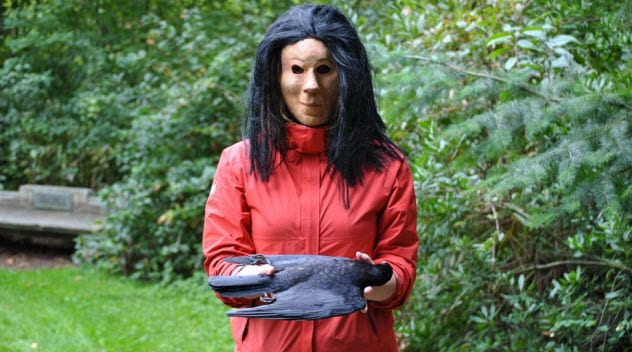
Some people believe that crows hold funerals for their dead. This is pure whimsy, but it is not hard to understand why the notion persists. Some birds cannot give a hoot when they encounter a dead member of their species. On the other hand, crows gather around a fallen friend, call to each other, and pay unusual attention to the situation.
However, they are not mourning the dead. The surviving flock recognizes that something killed a crow. They are crows. This thing can kill them, too. The show of concern is more about trying to find the threat and avoid it in the future.
A large study of dead crows involved over 100 breeding sites in Washington State. It found that the birds viewed humans who handled a dead crow as a threat. They persistently stayed wary of feeding near such a person, even when the dead crow was removed from the picture.
The birds did not brand any volunteers who stood there with empty hands or even with a dead pigeon. Those who held dead crows in the past (now empty-handed themselves) were scolded on sight for weeks.[2]
8 They Mob Ravens
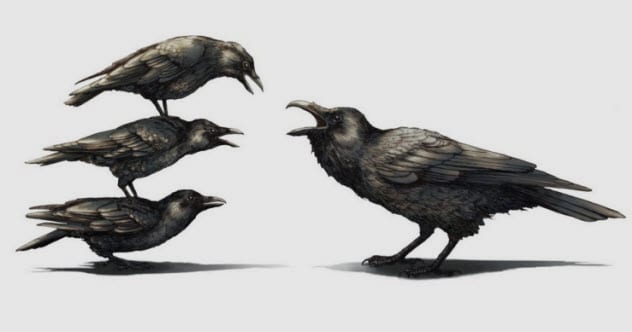
Crows and ravens belong to the same family and share a resemblance. However, the two species are not buddies. Ravens are much bigger and often help themselves to a crow’s eggs. Sometimes, they will even eat the crow. Even so, the smaller cousin is not an easy victim.
A recent study looked at both populations in cities and analyzed over 2,000 reports from bird-watchers describing interactions between crows and ravens. The results showed that crows actively worked together to ruin a raven’s day.
Crow gangs are so aggressive that ravens avoid populating great environments that contain such mobs. Many bird species rely on coordinated attacks to drive off a larger predator. However, none match the crows’ technique: 2–5 birds move in a cohesive, tightly knit squad.[3]
This successful behavior is largely due to the socialness of crows and the loner nature of ravens. Had ravens been more social and formed their own gangs, crows would come in a mangled second.
7 Aesop’s Fable Was True
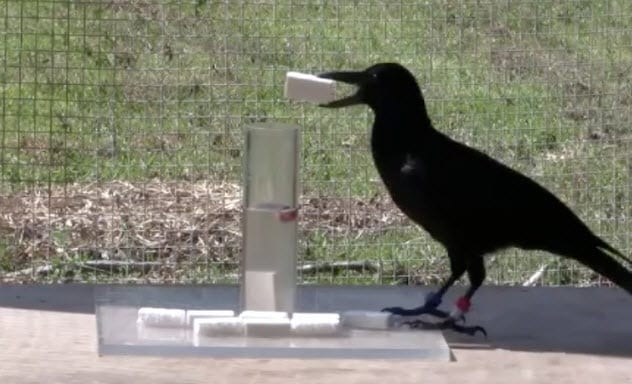
Ancient lore recognized the intelligence of crows. One of Aesop’s Fables is called “The Crow and the Pitcher” and describes a thirsty but clever crow. In need of a drink, it found a long jar. When it saw the water inside was just out of reach, the bird dropped pebbles into the vessel to raise the water level.
Researchers recently decided to test the fable but twisted it a little. Instead of making crows thirsty, they lured them with snacks. A pair of tubes contained water and delicious floating tidbits.
In front of the tubes were objects that the crows could drop to make the water level rise. Some were sneaky choices, like light polystyrene items and hollow cubes that would do nothing to help the birds. The rest consisted of heavy rubber pieces and solid cubes.
The six New Caledonian crows soon found out that the bait was just out of reach. Incredibly, they also grasped the concept of water displacement and eventually added the heavier items to make the snacks rise.[4]
6 They Eat Cane Toads
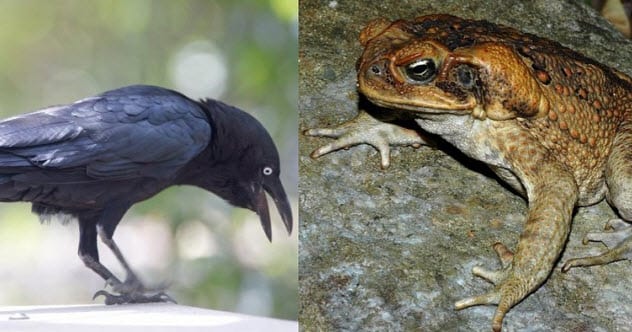
A crow having a toad lunch sounds fairly normal. However, not when the amphibian is Australia’s cane toad. This invasive species was taken to the continent in 1935 to control a pesky beetle. Now, the toad is a poisonous pest itself. The creature exudes a white gunk that can kill dogs, cats, snakes, and people. Worse, once the toads hit Australian soil, they flourished.
A survey in 2006 estimated the existence of around 200 million, thanks to a lack of predators that could keep the population under control. In 2018, a photographer captured the first evidence of crows filling that ecological void. Within 40 minutes, one bird ate a cane toad and lived to tell the tale.
Incredibly, it would appear that Australian crows figured out which parts are toxic. They avoid the white poison by grabbing the toad’s limbs or head and then roll it over to expose the belly. The crows then dine on the edible parts, like thighs, tongues, and intestines.[5]
5 They Hold Grudges
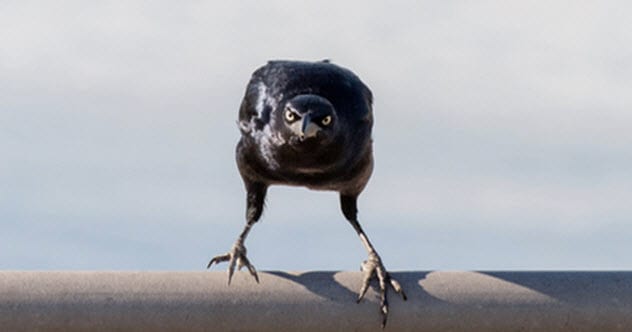
Better not tick off a crow. It will remember. A weird experiment proved that crows do not forgive the face that offends them. A study released in 2012 revealed that researchers went about Seattle and kidnapped some crows.
While wearing a mask called “the threatening face,” the researchers plucked 12 crows from the wild. The abducted flock was kept for four weeks. During that time, they were cared for by someone who wore a different mask called “the caring face.” Neither mask looked particularly grandmotherly or zombie-movie terrifying. Both were different but neutral.
Despite this, the birds matched the experience to the mask. During their captivity, they were exposed a few times to the threatening face before undergoing a brain scan. For the first time, researchers documented that the crow brain stored negative associations similarly to mammals.
Eventually, the birds were set free. The true depth of a crow’s inability to forgive became clear in a follow-up study. Years had passed, but the crows recognized a researcher wearing the “threatening” mask. They taunted him and even delivered a few dive-bomb attacks.[6]
4 Corpse Canoodling

Some crows are deviants. They like to hump their dead. In 2015, researchers did an extensive study of crows in Washington State. They lured crows with a stuffed bird to watch their reactions. Unexpectedly, one tried to mate with the bait. This created an unnecessary risk of catching a disease or getting killed by scavengers. It seemed like dumb behavior for an exceptionally smart species.
To find out how common this quirk was, the team decided to engage with 308 pairs of wild crows, all mated. They were presented with taxidermic crows, squirrels, and pigeons. The extra species were used to find out if the necrophilia extended to other animal corpses.
It did not. In fact, the behavior was rare. Just 4 percent of the crows had romance on the brain. They only mounted the stuffed crows. Clearly, the majority of crows shared the researchers’ feelings—corpse canoodling was a risky endeavor.[7]
Since the necrophiliacs also displayed heightened aggression, it could be that the stress of breeding season plus the alarming sight of a dead crow made them a little confused and angry.
3 They Visually Judge Weight
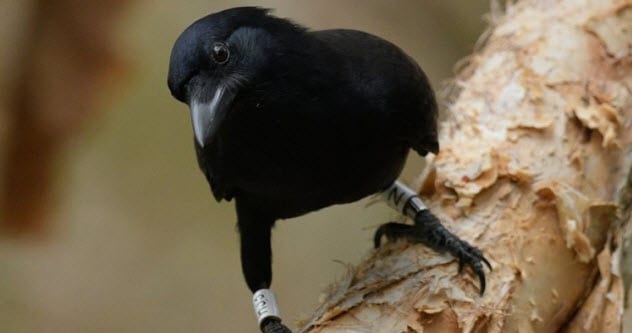
When humans observe a moving object, they can gauge its weight. For example, the way a leaf flutters in the wind shows lightness. This attribute was considered unique to humans, but then crows came along and changed everything. More specifically, 12 New Caledonian crows divided into two groups of six.
Their training was the same: Put an object in a box, and get a treat. However, one group was dispensed treats only when they dumped heavy items into the box. The other received goodies when they deposited light objects.
During the second stage of the recent study, the birds were shown two new items. These were things the crows had never seen before. For three days, they had to watch the suspended objects react to a fan.
Naturally, the lighter object moved more. They also observed the same things with the fan off when there was no movement. When given access to the fan objects, the birds—depending on their previous training—chose the right object first 73 percent of the time.[8]
2 Crow Versus Eagle
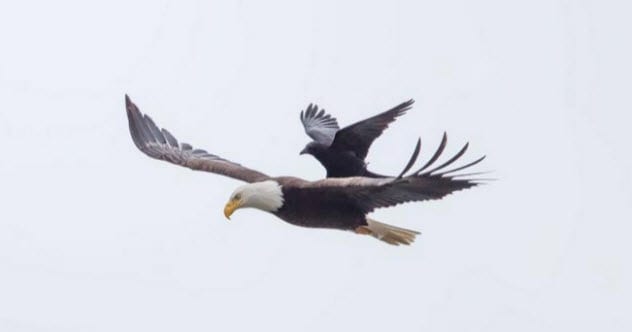
In 2015, a photographer named Phoo Chan took amazing photos. They showed an eagle and a crow in the California sky. Apparently, the crow decided to take on the larger predator single-handedly. Capturing the whole sequence, Chan’s photos followed the crow’s incoming attack and how it grabbed hold of the enemy.
Then, for some reason, the crow decided to sit on the eagle’s back. It gets weirder. The eagle did not give its passenger a second glance. When bird experts looked at the snaps, they did not find the crow’s decision to attack unusual. During the summer, crows get really crabby about airspace. Their hatchlings are on the menu, so adults tend to launch more aggressive attacks on intruders.
Even so, a single crow dicing with a giant eagle and then making itself comfortable on the other bird’s back is uncommon. Why was the eagle so unconcerned? They get harassed in the air by other species so much that one more attack is nothing new. The crow was passive once it landed, and that could be why the eagle just ignored it.[9]
1 They Build Compound Tools
In 2018, a group of New Caledonian crows stunned scientists. They displayed an ability only previously seen in primates. To reach a snack inside a box, they built compound tools.
The fact that this ability has been found in birds is remarkable. But what makes it so special is that the birds received no training except to understand the purpose of the box. (They had to maneuver a snack out with a long object.)
After they grasped this, they were left with parts too short individually to get to the food. The secret was to assemble them. When presented with the challenge, the crows assembled the pieces within 4–6 minutes after the experiment had started.[10]
Once finished, the lengthy tool was used to push the treat toward an opening in the box. This feat required perseverance and dexterity but also the ability to think into the future. To assemble the pieces, the crows had to think ahead and imagine how it would all fit together before actually doing so.
Read more fascinating facts about crows on 10 Crows And Ravens From World Religion and Top 10 Times Animals Held Grudges Against Humans And Took Revenge.








